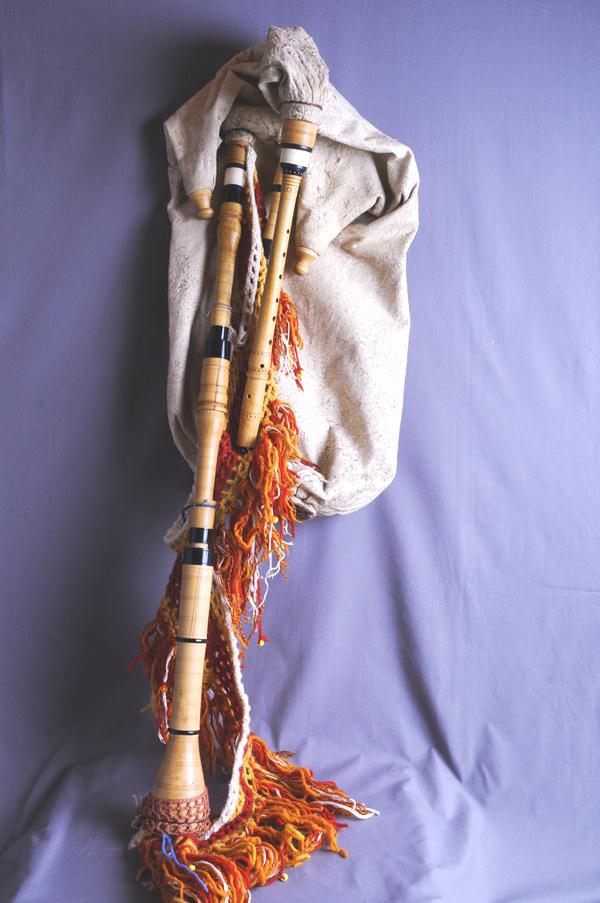(bodega or craba in Occitan)
The second type of bagpipe that I make is the Boudègue. I began making it in the early 90’s based on the work accomplished by Charles Alexandre and Claude Romero, both musicians from Southern France. The revival of the Boudègue began 1970 thanks to the Charles Alexandre collectage. The term of “Bodega” derives directly from the Occitan “bot / bota”, which signifies bag. One uses a whole goat’s skin, called “oire” and it was the tradition to kill the animal during the old winter moon, choosing a female goat rather than a male, because of the odour. The chanter of the boudègue is called “graïle” and is equipped with a double reed, entirely cut from the body of the cane, resulting in a rather unique technique in this kind of reed-making. The drone, called “bonda”, sounds two octaves below the “graïle” and is composed of three parts, of which the last possesses a large resonator. The drone rests on the shoulder, in a very wide-spread style in Europe. This large bagpipe closely resembles the images that one has of those of the Middle-ages. (cf. Enluminure de bréviaire d’amour d’un moine franciscain de Béziers – 1321).
We have also found an engraving, figuring in a register from the Labruguière region (Tarn), and one of the oldest written testaments mentioning the boudègue is to be found in the “Dictiounari Moundi” of J. Doujat from Toulouse. The former cites the word “boudègo”, giving it the definition of bagpipe. The playing area of the Boudègue extended over four french departments: Aude, Herault, Upper-Garonne and Tarn. At the beginning of the 20th cent. one still could count several hundred boudègue players in a zone including the Castres region, the Lacaune hills, the black mountains and the Lauragais. Given its carnival-like character, this instrument was often used during street festivals. The musician was disguised and had as a custom to decorate the bodègue with all manner of pompoms and other knitted garlands. The colours had to be as bright and eye-catching as possible. The boudègue was in great use for weddings and for all manner of life-pleasures. The repertory is composed of “bourrées” and numerous dances typical of the Tarn: La Bufatièra, the Buta Vam, the Branlou and the Virolet.
Coming from an ageless tradition, the boudègue is, to my way of thinking, one of the most performant occitan bagpipes. Of a deep and stirring sound, they are distinct from the other european bag pipes that are generally much more strident. Thanks to its chromatic possibilities, the Boudègue allows one to play all the styles of traditional as well as modern repertory.
The technique of the fabrication is quite exacting, and the tools used must be of great precision. For example : the chanter bore is made of four distinct conicity, the reamer is very specialized tool, difficult to make. Given it’s over-sized dimensions, the drone with its resonator, is itself rather complicated to produce in order to have a homogenous and balanced result, as much musically as aesthetically speaking.
The boudègue is, for my taste, one of the most appealing bagpipes that I have encountered.



